Financial Management Report: Financial Analysis and Recommendations
VerifiedAdded on 2023/01/12
|13
|3681
|20
Report
AI Summary
This financial management report analyzes key concepts related to corporate finance. The report begins with an introduction to financial management, emphasizing its role in business operations. The main body delves into two primary questions: the first question examines valuation models (Price Earnings Ratio, Dividend Valuation Model, and Discounted Cash Flow) and their application to a merger or takeover scenario involving Aztec and Trojan Plc, with a recommendation for the Aztec board. The second question focuses on investment appraisal techniques (Payback Period, Accounting Rate of Return, Net Present Value, and Internal Rate of Return) to evaluate potential investments. The report calculates and compares these metrics to assess the financial viability of different investment options. The conclusion summarizes the key findings and recommendations regarding valuation and investment decisions. References are provided to support the analysis.

Financial Management
1
1
Paraphrase This Document
Need a fresh take? Get an instant paraphrase of this document with our AI Paraphraser
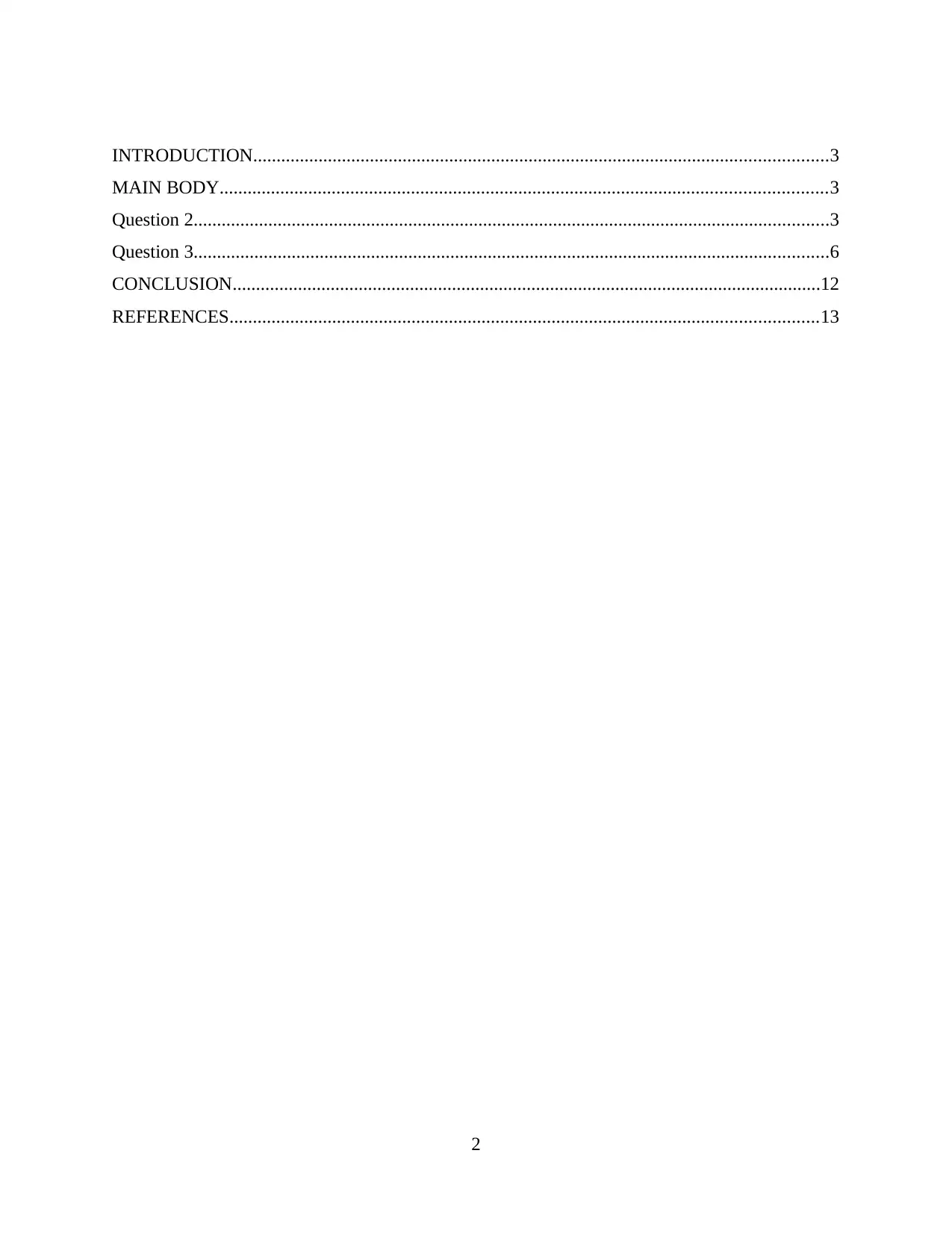
INTRODUCTION...........................................................................................................................3
MAIN BODY..................................................................................................................................3
Question 2........................................................................................................................................3
Question 3........................................................................................................................................6
CONCLUSION..............................................................................................................................12
REFERENCES..............................................................................................................................13
2
MAIN BODY..................................................................................................................................3
Question 2........................................................................................................................................3
Question 3........................................................................................................................................6
CONCLUSION..............................................................................................................................12
REFERENCES..............................................................................................................................13
2
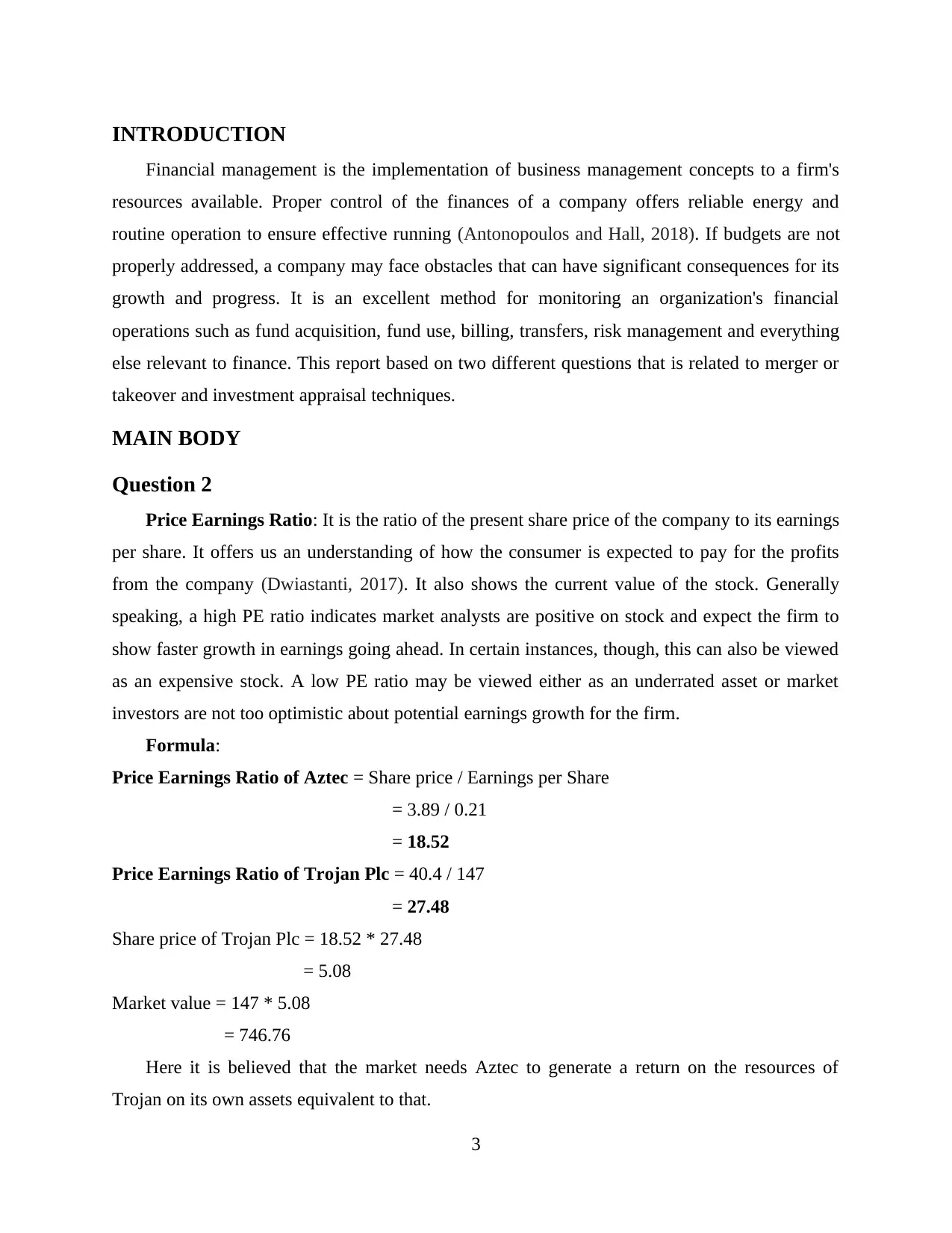
INTRODUCTION
Financial management is the implementation of business management concepts to a firm's
resources available. Proper control of the finances of a company offers reliable energy and
routine operation to ensure effective running (Antonopoulos and Hall, 2018). If budgets are not
properly addressed, a company may face obstacles that can have significant consequences for its
growth and progress. It is an excellent method for monitoring an organization's financial
operations such as fund acquisition, fund use, billing, transfers, risk management and everything
else relevant to finance. This report based on two different questions that is related to merger or
takeover and investment appraisal techniques.
MAIN BODY
Question 2
Price Earnings Ratio: It is the ratio of the present share price of the company to its earnings
per share. It offers us an understanding of how the consumer is expected to pay for the profits
from the company (Dwiastanti, 2017). It also shows the current value of the stock. Generally
speaking, a high PE ratio indicates market analysts are positive on stock and expect the firm to
show faster growth in earnings going ahead. In certain instances, though, this can also be viewed
as an expensive stock. A low PE ratio may be viewed either as an underrated asset or market
investors are not too optimistic about potential earnings growth for the firm.
Formula:
Price Earnings Ratio of Aztec = Share price / Earnings per Share
= 3.89 / 0.21
= 18.52
Price Earnings Ratio of Trojan Plc = 40.4 / 147
= 27.48
Share price of Trojan Plc = 18.52 * 27.48
= 5.08
Market value = 147 * 5.08
= 746.76
Here it is believed that the market needs Aztec to generate a return on the resources of
Trojan on its own assets equivalent to that.
3
Financial management is the implementation of business management concepts to a firm's
resources available. Proper control of the finances of a company offers reliable energy and
routine operation to ensure effective running (Antonopoulos and Hall, 2018). If budgets are not
properly addressed, a company may face obstacles that can have significant consequences for its
growth and progress. It is an excellent method for monitoring an organization's financial
operations such as fund acquisition, fund use, billing, transfers, risk management and everything
else relevant to finance. This report based on two different questions that is related to merger or
takeover and investment appraisal techniques.
MAIN BODY
Question 2
Price Earnings Ratio: It is the ratio of the present share price of the company to its earnings
per share. It offers us an understanding of how the consumer is expected to pay for the profits
from the company (Dwiastanti, 2017). It also shows the current value of the stock. Generally
speaking, a high PE ratio indicates market analysts are positive on stock and expect the firm to
show faster growth in earnings going ahead. In certain instances, though, this can also be viewed
as an expensive stock. A low PE ratio may be viewed either as an underrated asset or market
investors are not too optimistic about potential earnings growth for the firm.
Formula:
Price Earnings Ratio of Aztec = Share price / Earnings per Share
= 3.89 / 0.21
= 18.52
Price Earnings Ratio of Trojan Plc = 40.4 / 147
= 27.48
Share price of Trojan Plc = 18.52 * 27.48
= 5.08
Market value = 147 * 5.08
= 746.76
Here it is believed that the market needs Aztec to generate a return on the resources of
Trojan on its own assets equivalent to that.
3
⊘ This is a preview!⊘
Do you want full access?
Subscribe today to unlock all pages.

Trusted by 1+ million students worldwide
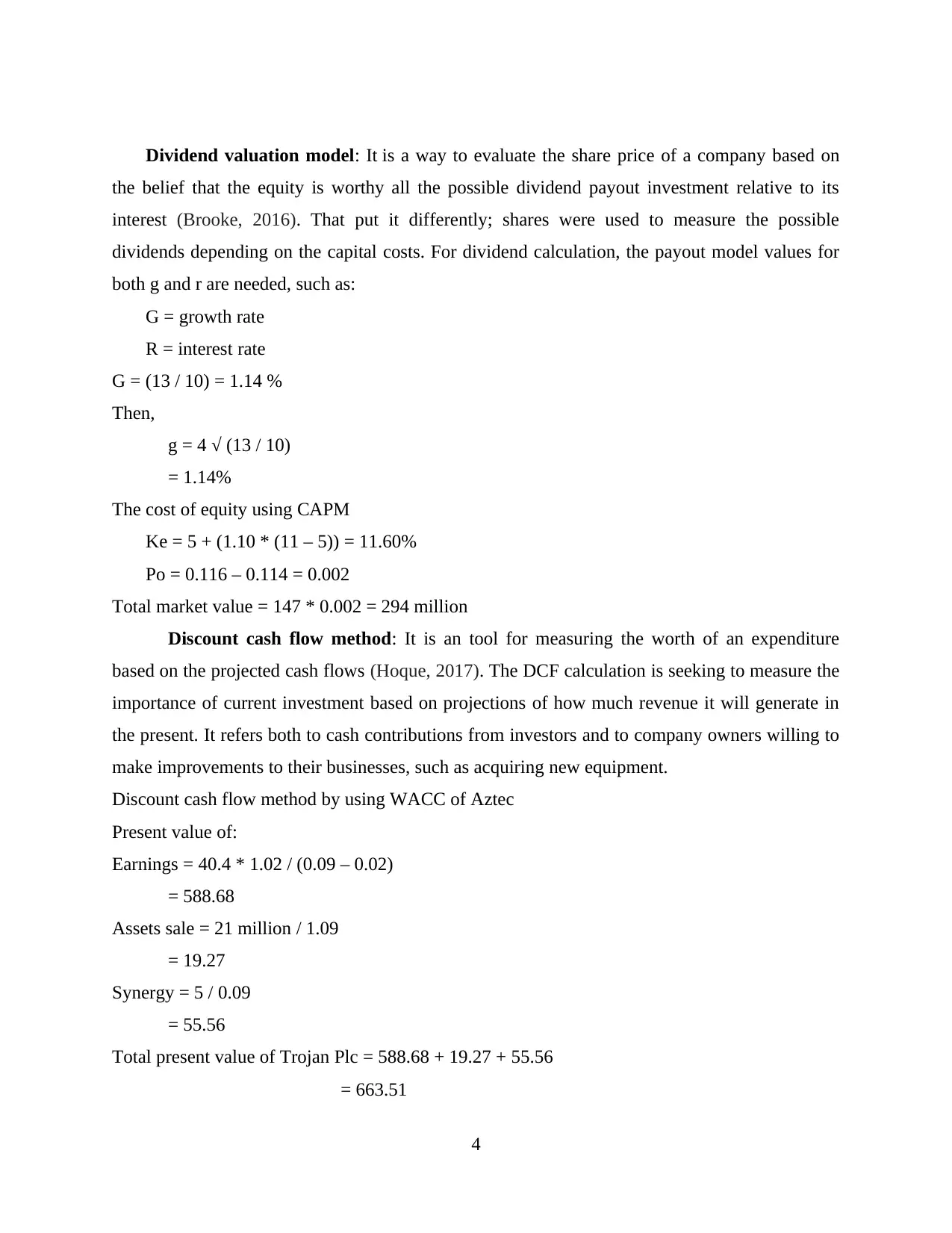
Dividend valuation model: It is a way to evaluate the share price of a company based on
the belief that the equity is worthy all the possible dividend payout investment relative to its
interest (Brooke, 2016). That put it differently; shares were used to measure the possible
dividends depending on the capital costs. For dividend calculation, the payout model values for
both g and r are needed, such as:
G = growth rate
R = interest rate
G = (13 / 10) = 1.14 %
Then,
g = 4 √ (13 / 10)
= 1.14%
The cost of equity using CAPM
Ke = 5 + (1.10 * (11 – 5)) = 11.60%
Po = 0.116 – 0.114 = 0.002
Total market value = 147 * 0.002 = 294 million
Discount cash flow method: It is an tool for measuring the worth of an expenditure
based on the projected cash flows (Hoque, 2017). The DCF calculation is seeking to measure the
importance of current investment based on projections of how much revenue it will generate in
the present. It refers both to cash contributions from investors and to company owners willing to
make improvements to their businesses, such as acquiring new equipment.
Discount cash flow method by using WACC of Aztec
Present value of:
Earnings = 40.4 * 1.02 / (0.09 – 0.02)
= 588.68
Assets sale = 21 million / 1.09
= 19.27
Synergy = 5 / 0.09
= 55.56
Total present value of Trojan Plc = 588.68 + 19.27 + 55.56
= 663.51
4
the belief that the equity is worthy all the possible dividend payout investment relative to its
interest (Brooke, 2016). That put it differently; shares were used to measure the possible
dividends depending on the capital costs. For dividend calculation, the payout model values for
both g and r are needed, such as:
G = growth rate
R = interest rate
G = (13 / 10) = 1.14 %
Then,
g = 4 √ (13 / 10)
= 1.14%
The cost of equity using CAPM
Ke = 5 + (1.10 * (11 – 5)) = 11.60%
Po = 0.116 – 0.114 = 0.002
Total market value = 147 * 0.002 = 294 million
Discount cash flow method: It is an tool for measuring the worth of an expenditure
based on the projected cash flows (Hoque, 2017). The DCF calculation is seeking to measure the
importance of current investment based on projections of how much revenue it will generate in
the present. It refers both to cash contributions from investors and to company owners willing to
make improvements to their businesses, such as acquiring new equipment.
Discount cash flow method by using WACC of Aztec
Present value of:
Earnings = 40.4 * 1.02 / (0.09 – 0.02)
= 588.68
Assets sale = 21 million / 1.09
= 19.27
Synergy = 5 / 0.09
= 55.56
Total present value of Trojan Plc = 588.68 + 19.27 + 55.56
= 663.51
4
Paraphrase This Document
Need a fresh take? Get an instant paraphrase of this document with our AI Paraphraser
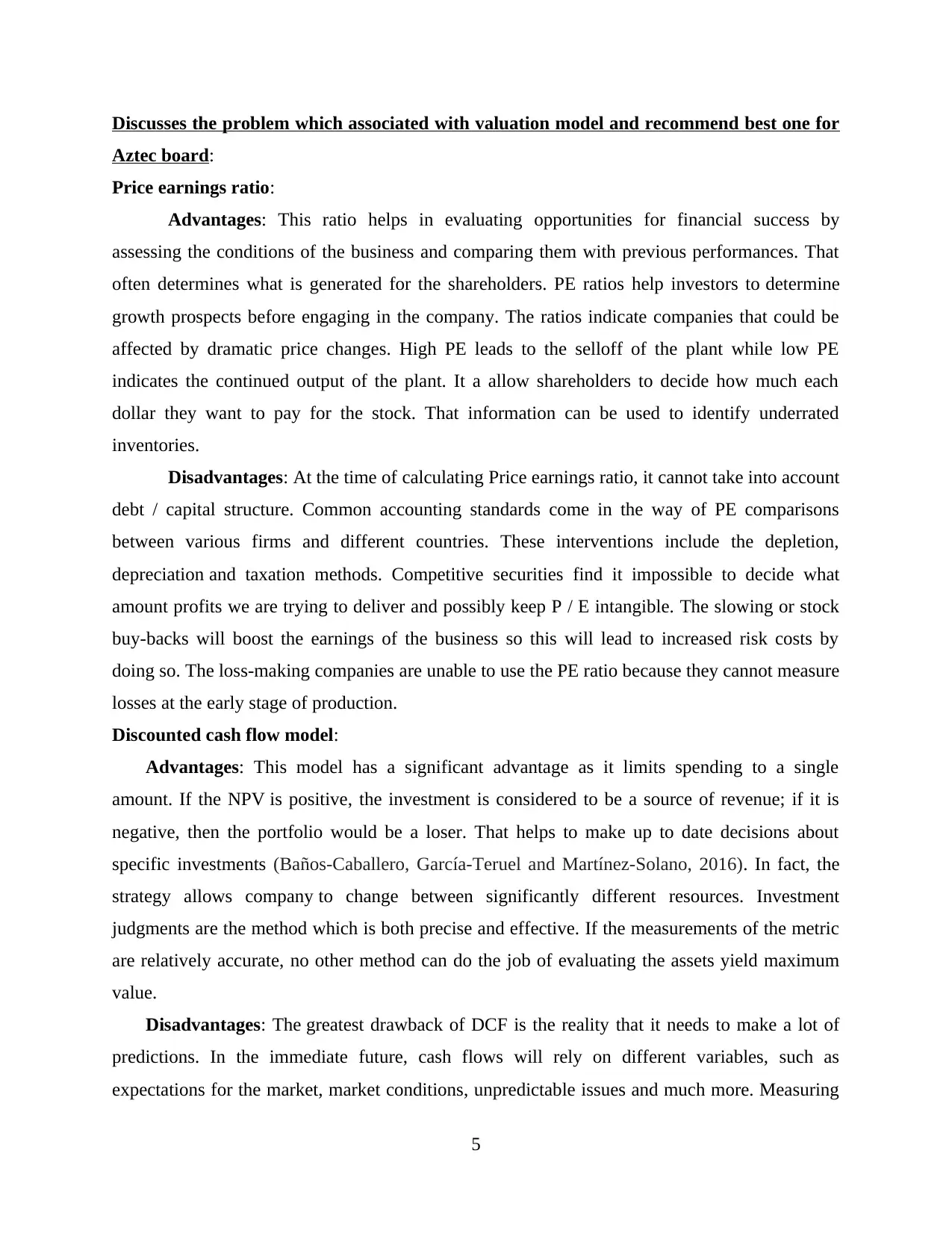
Discusses the problem which associated with valuation model and recommend best one for
Aztec board:
Price earnings ratio:
Advantages: This ratio helps in evaluating opportunities for financial success by
assessing the conditions of the business and comparing them with previous performances. That
often determines what is generated for the shareholders. PE ratios help investors to determine
growth prospects before engaging in the company. The ratios indicate companies that could be
affected by dramatic price changes. High PE leads to the selloff of the plant while low PE
indicates the continued output of the plant. It a allow shareholders to decide how much each
dollar they want to pay for the stock. That information can be used to identify underrated
inventories.
Disadvantages: At the time of calculating Price earnings ratio, it cannot take into account
debt / capital structure. Common accounting standards come in the way of PE comparisons
between various firms and different countries. These interventions include the depletion,
depreciation and taxation methods. Competitive securities find it impossible to decide what
amount profits we are trying to deliver and possibly keep P / E intangible. The slowing or stock
buy-backs will boost the earnings of the business so this will lead to increased risk costs by
doing so. The loss-making companies are unable to use the PE ratio because they cannot measure
losses at the early stage of production.
Discounted cash flow model:
Advantages: This model has a significant advantage as it limits spending to a single
amount. If the NPV is positive, the investment is considered to be a source of revenue; if it is
negative, then the portfolio would be a loser. That helps to make up to date decisions about
specific investments (Baños-Caballero, García-Teruel and Martínez-Solano, 2016). In fact, the
strategy allows company to change between significantly different resources. Investment
judgments are the method which is both precise and effective. If the measurements of the metric
are relatively accurate, no other method can do the job of evaluating the assets yield maximum
value.
Disadvantages: The greatest drawback of DCF is the reality that it needs to make a lot of
predictions. In the immediate future, cash flows will rely on different variables, such as
expectations for the market, market conditions, unpredictable issues and much more. Measuring
5
Aztec board:
Price earnings ratio:
Advantages: This ratio helps in evaluating opportunities for financial success by
assessing the conditions of the business and comparing them with previous performances. That
often determines what is generated for the shareholders. PE ratios help investors to determine
growth prospects before engaging in the company. The ratios indicate companies that could be
affected by dramatic price changes. High PE leads to the selloff of the plant while low PE
indicates the continued output of the plant. It a allow shareholders to decide how much each
dollar they want to pay for the stock. That information can be used to identify underrated
inventories.
Disadvantages: At the time of calculating Price earnings ratio, it cannot take into account
debt / capital structure. Common accounting standards come in the way of PE comparisons
between various firms and different countries. These interventions include the depletion,
depreciation and taxation methods. Competitive securities find it impossible to decide what
amount profits we are trying to deliver and possibly keep P / E intangible. The slowing or stock
buy-backs will boost the earnings of the business so this will lead to increased risk costs by
doing so. The loss-making companies are unable to use the PE ratio because they cannot measure
losses at the early stage of production.
Discounted cash flow model:
Advantages: This model has a significant advantage as it limits spending to a single
amount. If the NPV is positive, the investment is considered to be a source of revenue; if it is
negative, then the portfolio would be a loser. That helps to make up to date decisions about
specific investments (Baños-Caballero, García-Teruel and Martínez-Solano, 2016). In fact, the
strategy allows company to change between significantly different resources. Investment
judgments are the method which is both precise and effective. If the measurements of the metric
are relatively accurate, no other method can do the job of evaluating the assets yield maximum
value.
Disadvantages: The greatest drawback of DCF is the reality that it needs to make a lot of
predictions. In the immediate future, cash flows will rely on different variables, such as
expectations for the market, market conditions, unpredictable issues and much more. Measuring
5
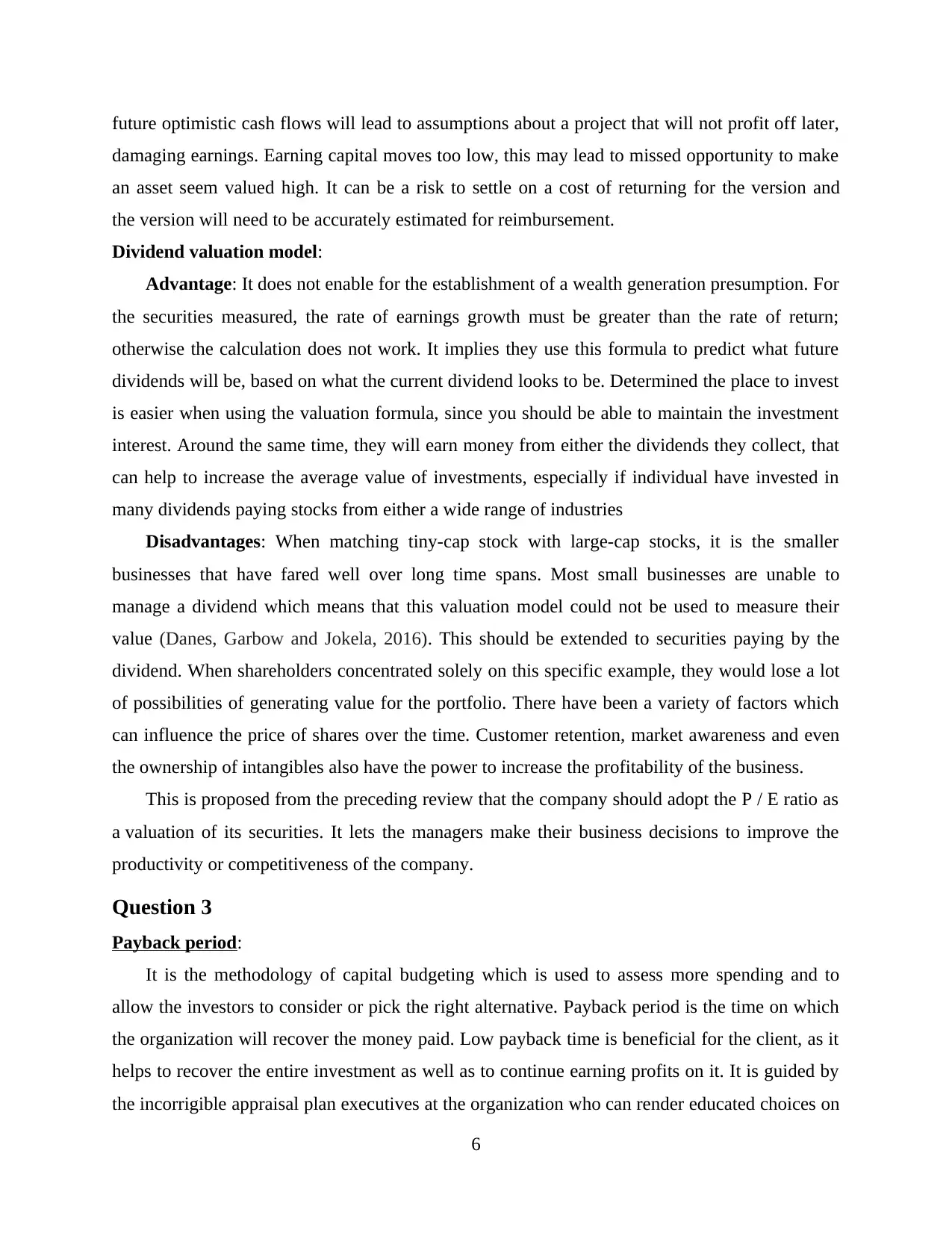
future optimistic cash flows will lead to assumptions about a project that will not profit off later,
damaging earnings. Earning capital moves too low, this may lead to missed opportunity to make
an asset seem valued high. It can be a risk to settle on a cost of returning for the version and
the version will need to be accurately estimated for reimbursement.
Dividend valuation model:
Advantage: It does not enable for the establishment of a wealth generation presumption. For
the securities measured, the rate of earnings growth must be greater than the rate of return;
otherwise the calculation does not work. It implies they use this formula to predict what future
dividends will be, based on what the current dividend looks to be. Determined the place to invest
is easier when using the valuation formula, since you should be able to maintain the investment
interest. Around the same time, they will earn money from either the dividends they collect, that
can help to increase the average value of investments, especially if individual have invested in
many dividends paying stocks from either a wide range of industries
Disadvantages: When matching tiny-cap stock with large-cap stocks, it is the smaller
businesses that have fared well over long time spans. Most small businesses are unable to
manage a dividend which means that this valuation model could not be used to measure their
value (Danes, Garbow and Jokela, 2016). This should be extended to securities paying by the
dividend. When shareholders concentrated solely on this specific example, they would lose a lot
of possibilities of generating value for the portfolio. There have been a variety of factors which
can influence the price of shares over the time. Customer retention, market awareness and even
the ownership of intangibles also have the power to increase the profitability of the business.
This is proposed from the preceding review that the company should adopt the P / E ratio as
a valuation of its securities. It lets the managers make their business decisions to improve the
productivity or competitiveness of the company.
Question 3
Payback period:
It is the methodology of capital budgeting which is used to assess more spending and to
allow the investors to consider or pick the right alternative. Payback period is the time on which
the organization will recover the money paid. Low payback time is beneficial for the client, as it
helps to recover the entire investment as well as to continue earning profits on it. It is guided by
the incorrigible appraisal plan executives at the organization who can render educated choices on
6
damaging earnings. Earning capital moves too low, this may lead to missed opportunity to make
an asset seem valued high. It can be a risk to settle on a cost of returning for the version and
the version will need to be accurately estimated for reimbursement.
Dividend valuation model:
Advantage: It does not enable for the establishment of a wealth generation presumption. For
the securities measured, the rate of earnings growth must be greater than the rate of return;
otherwise the calculation does not work. It implies they use this formula to predict what future
dividends will be, based on what the current dividend looks to be. Determined the place to invest
is easier when using the valuation formula, since you should be able to maintain the investment
interest. Around the same time, they will earn money from either the dividends they collect, that
can help to increase the average value of investments, especially if individual have invested in
many dividends paying stocks from either a wide range of industries
Disadvantages: When matching tiny-cap stock with large-cap stocks, it is the smaller
businesses that have fared well over long time spans. Most small businesses are unable to
manage a dividend which means that this valuation model could not be used to measure their
value (Danes, Garbow and Jokela, 2016). This should be extended to securities paying by the
dividend. When shareholders concentrated solely on this specific example, they would lose a lot
of possibilities of generating value for the portfolio. There have been a variety of factors which
can influence the price of shares over the time. Customer retention, market awareness and even
the ownership of intangibles also have the power to increase the profitability of the business.
This is proposed from the preceding review that the company should adopt the P / E ratio as
a valuation of its securities. It lets the managers make their business decisions to improve the
productivity or competitiveness of the company.
Question 3
Payback period:
It is the methodology of capital budgeting which is used to assess more spending and to
allow the investors to consider or pick the right alternative. Payback period is the time on which
the organization will recover the money paid. Low payback time is beneficial for the client, as it
helps to recover the entire investment as well as to continue earning profits on it. It is guided by
the incorrigible appraisal plan executives at the organization who can render educated choices on
6
⊘ This is a preview!⊘
Do you want full access?
Subscribe today to unlock all pages.

Trusted by 1+ million students worldwide
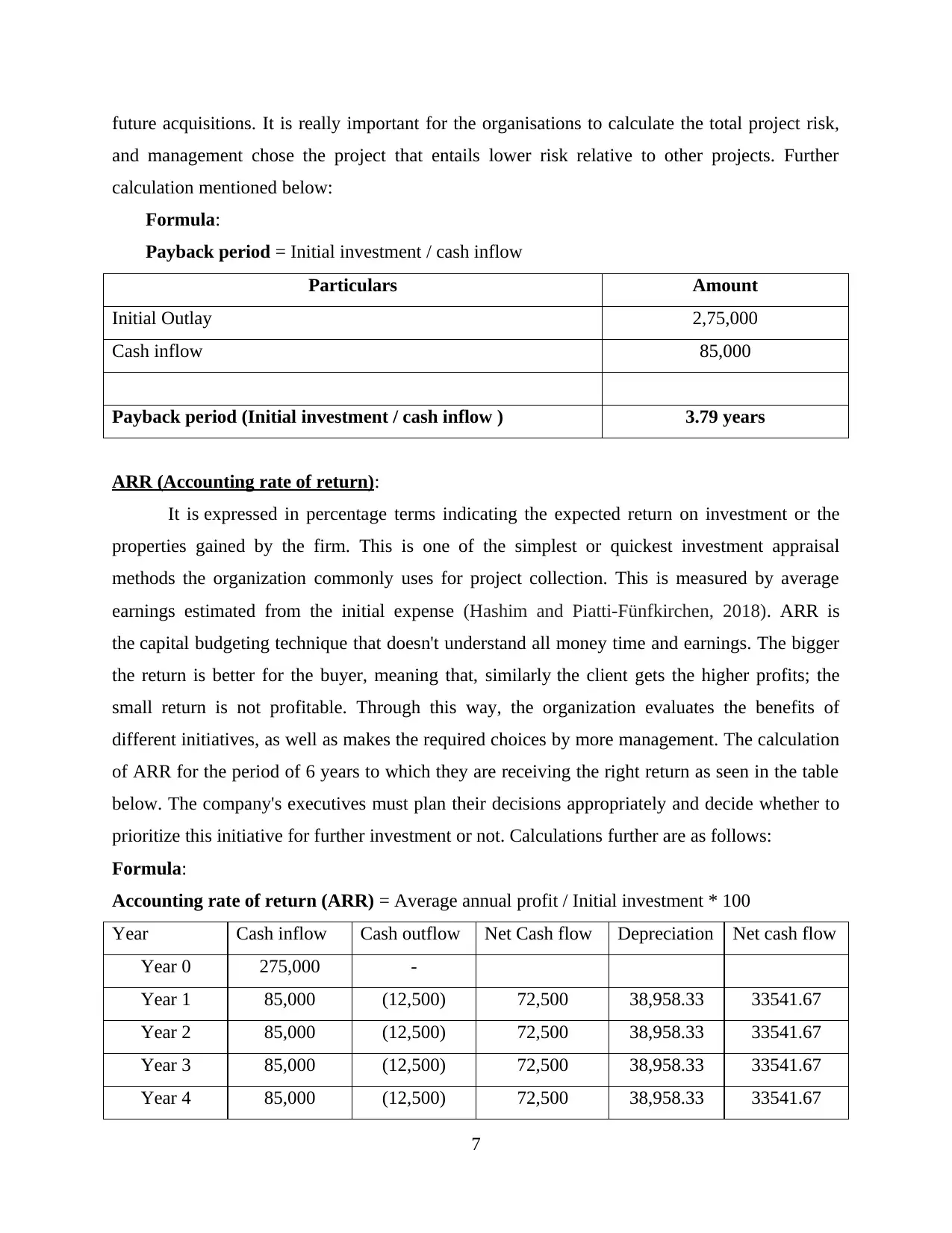
future acquisitions. It is really important for the organisations to calculate the total project risk,
and management chose the project that entails lower risk relative to other projects. Further
calculation mentioned below:
Formula:
Payback period = Initial investment / cash inflow
Particulars Amount
Initial Outlay 2,75,000
Cash inflow 85,000
Payback period (Initial investment / cash inflow ) 3.79 years
ARR (Accounting rate of return):
It is expressed in percentage terms indicating the expected return on investment or the
properties gained by the firm. This is one of the simplest or quickest investment appraisal
methods the organization commonly uses for project collection. This is measured by average
earnings estimated from the initial expense (Hashim and Piatti-Fünfkirchen, 2018). ARR is
the capital budgeting technique that doesn't understand all money time and earnings. The bigger
the return is better for the buyer, meaning that, similarly the client gets the higher profits; the
small return is not profitable. Through this way, the organization evaluates the benefits of
different initiatives, as well as makes the required choices by more management. The calculation
of ARR for the period of 6 years to which they are receiving the right return as seen in the table
below. The company's executives must plan their decisions appropriately and decide whether to
prioritize this initiative for further investment or not. Calculations further are as follows:
Formula:
Accounting rate of return (ARR) = Average annual profit / Initial investment * 100
Year Cash inflow Cash outflow Net Cash flow Depreciation Net cash flow
Year 0 275,000 -
Year 1 85,000 (12,500) 72,500 38,958.33 33541.67
Year 2 85,000 (12,500) 72,500 38,958.33 33541.67
Year 3 85,000 (12,500) 72,500 38,958.33 33541.67
Year 4 85,000 (12,500) 72,500 38,958.33 33541.67
7
and management chose the project that entails lower risk relative to other projects. Further
calculation mentioned below:
Formula:
Payback period = Initial investment / cash inflow
Particulars Amount
Initial Outlay 2,75,000
Cash inflow 85,000
Payback period (Initial investment / cash inflow ) 3.79 years
ARR (Accounting rate of return):
It is expressed in percentage terms indicating the expected return on investment or the
properties gained by the firm. This is one of the simplest or quickest investment appraisal
methods the organization commonly uses for project collection. This is measured by average
earnings estimated from the initial expense (Hashim and Piatti-Fünfkirchen, 2018). ARR is
the capital budgeting technique that doesn't understand all money time and earnings. The bigger
the return is better for the buyer, meaning that, similarly the client gets the higher profits; the
small return is not profitable. Through this way, the organization evaluates the benefits of
different initiatives, as well as makes the required choices by more management. The calculation
of ARR for the period of 6 years to which they are receiving the right return as seen in the table
below. The company's executives must plan their decisions appropriately and decide whether to
prioritize this initiative for further investment or not. Calculations further are as follows:
Formula:
Accounting rate of return (ARR) = Average annual profit / Initial investment * 100
Year Cash inflow Cash outflow Net Cash flow Depreciation Net cash flow
Year 0 275,000 -
Year 1 85,000 (12,500) 72,500 38,958.33 33541.67
Year 2 85,000 (12,500) 72,500 38,958.33 33541.67
Year 3 85,000 (12,500) 72,500 38,958.33 33541.67
Year 4 85,000 (12,500) 72,500 38,958.33 33541.67
7
Paraphrase This Document
Need a fresh take? Get an instant paraphrase of this document with our AI Paraphraser
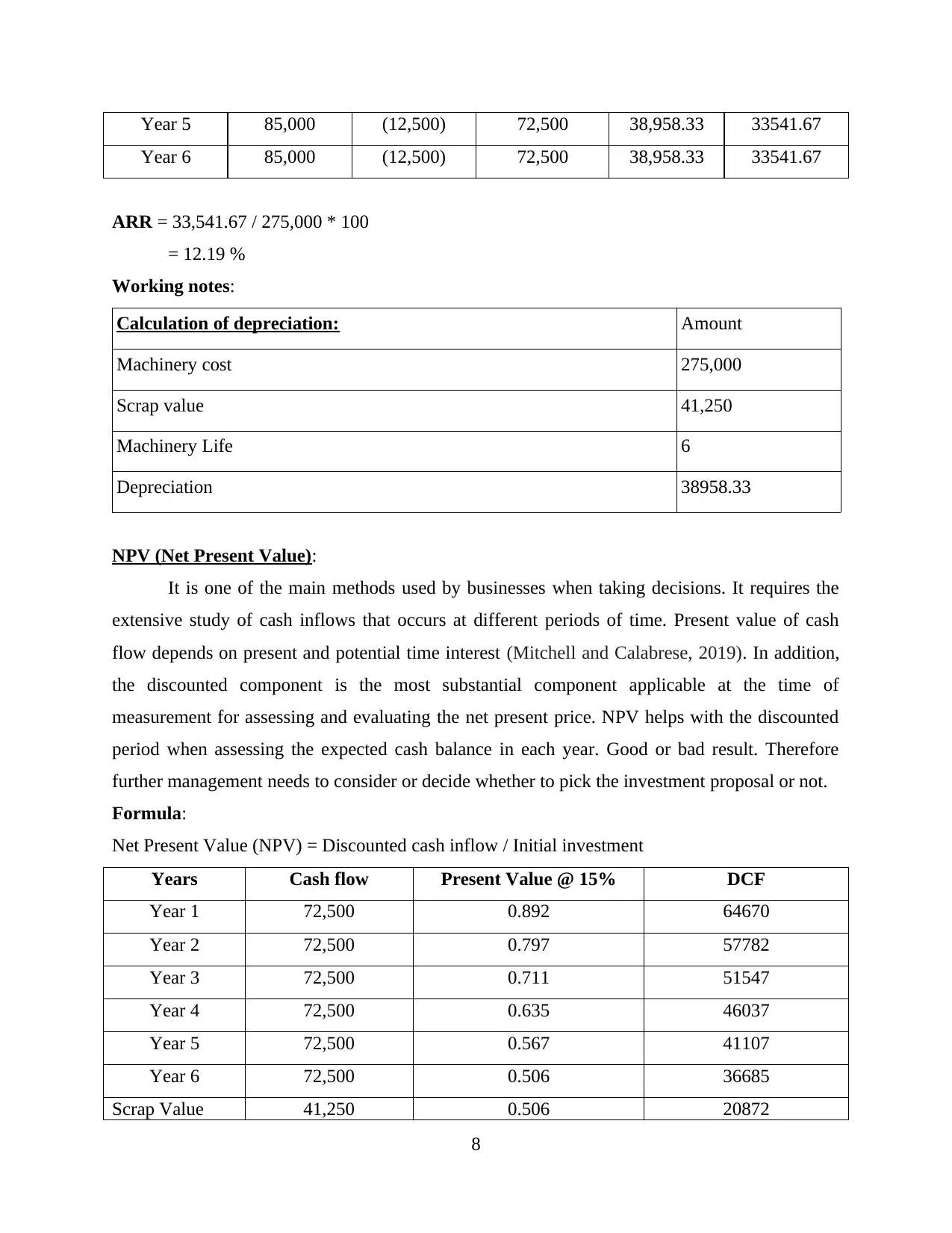
Year 5 85,000 (12,500) 72,500 38,958.33 33541.67
Year 6 85,000 (12,500) 72,500 38,958.33 33541.67
ARR = 33,541.67 / 275,000 * 100
= 12.19 %
Working notes:
Calculation of depreciation: Amount
Machinery cost 275,000
Scrap value 41,250
Machinery Life 6
Depreciation 38958.33
NPV (Net Present Value):
It is one of the main methods used by businesses when taking decisions. It requires the
extensive study of cash inflows that occurs at different periods of time. Present value of cash
flow depends on present and potential time interest (Mitchell and Calabrese, 2019). In addition,
the discounted component is the most substantial component applicable at the time of
measurement for assessing and evaluating the net present price. NPV helps with the discounted
period when assessing the expected cash balance in each year. Good or bad result. Therefore
further management needs to consider or decide whether to pick the investment proposal or not.
Formula:
Net Present Value (NPV) = Discounted cash inflow / Initial investment
Years Cash flow Present Value @ 15% DCF
Year 1 72,500 0.892 64670
Year 2 72,500 0.797 57782
Year 3 72,500 0.711 51547
Year 4 72,500 0.635 46037
Year 5 72,500 0.567 41107
Year 6 72,500 0.506 36685
Scrap Value 41,250 0.506 20872
8
Year 6 85,000 (12,500) 72,500 38,958.33 33541.67
ARR = 33,541.67 / 275,000 * 100
= 12.19 %
Working notes:
Calculation of depreciation: Amount
Machinery cost 275,000
Scrap value 41,250
Machinery Life 6
Depreciation 38958.33
NPV (Net Present Value):
It is one of the main methods used by businesses when taking decisions. It requires the
extensive study of cash inflows that occurs at different periods of time. Present value of cash
flow depends on present and potential time interest (Mitchell and Calabrese, 2019). In addition,
the discounted component is the most substantial component applicable at the time of
measurement for assessing and evaluating the net present price. NPV helps with the discounted
period when assessing the expected cash balance in each year. Good or bad result. Therefore
further management needs to consider or decide whether to pick the investment proposal or not.
Formula:
Net Present Value (NPV) = Discounted cash inflow / Initial investment
Years Cash flow Present Value @ 15% DCF
Year 1 72,500 0.892 64670
Year 2 72,500 0.797 57782
Year 3 72,500 0.711 51547
Year 4 72,500 0.635 46037
Year 5 72,500 0.567 41107
Year 6 72,500 0.506 36685
Scrap Value 41,250 0.506 20872
8
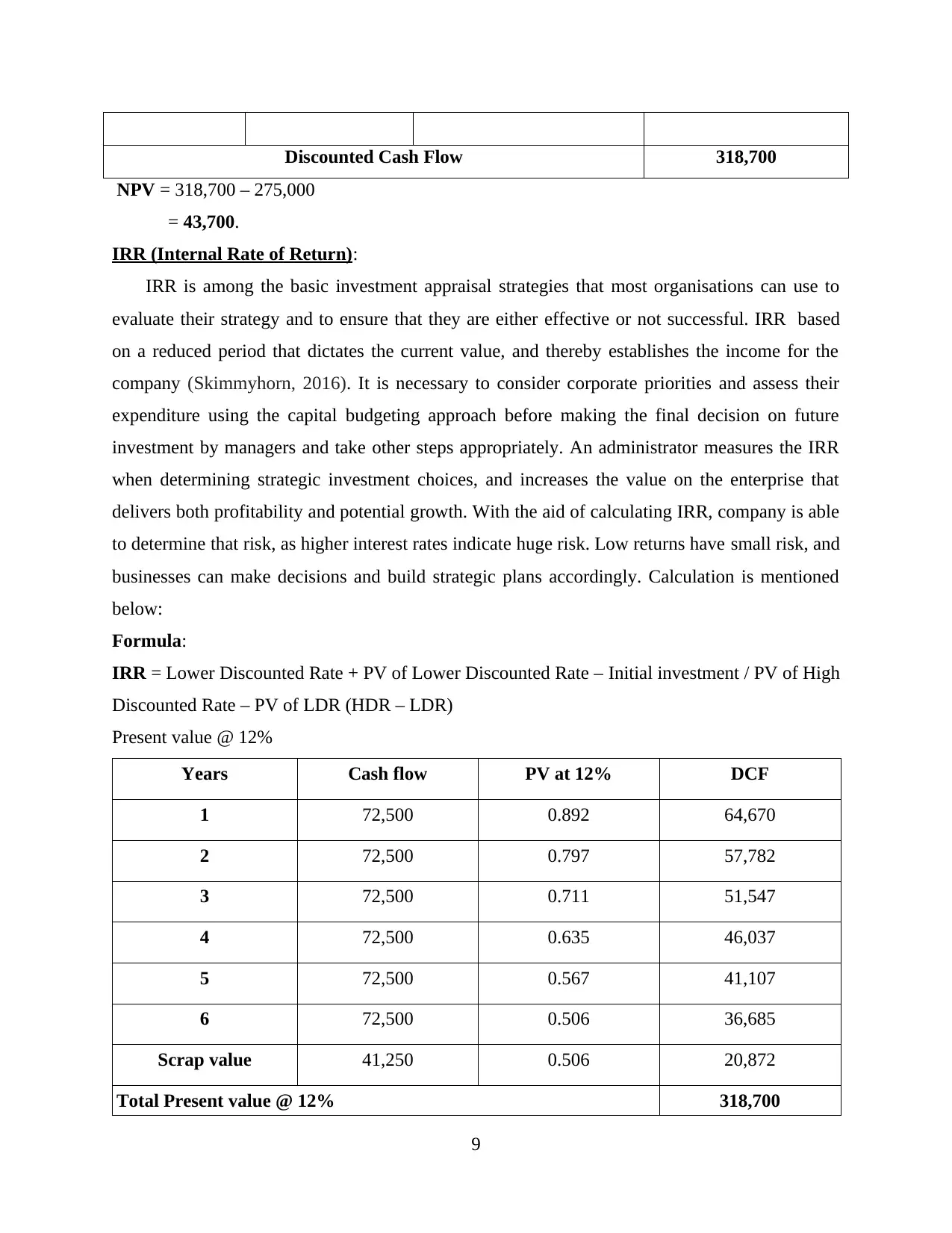
Discounted Cash Flow 318,700
NPV = 318,700 – 275,000
= 43,700.
IRR (Internal Rate of Return):
IRR is among the basic investment appraisal strategies that most organisations can use to
evaluate their strategy and to ensure that they are either effective or not successful. IRR based
on a reduced period that dictates the current value, and thereby establishes the income for the
company (Skimmyhorn, 2016). It is necessary to consider corporate priorities and assess their
expenditure using the capital budgeting approach before making the final decision on future
investment by managers and take other steps appropriately. An administrator measures the IRR
when determining strategic investment choices, and increases the value on the enterprise that
delivers both profitability and potential growth. With the aid of calculating IRR, company is able
to determine that risk, as higher interest rates indicate huge risk. Low returns have small risk, and
businesses can make decisions and build strategic plans accordingly. Calculation is mentioned
below:
Formula:
IRR = Lower Discounted Rate + PV of Lower Discounted Rate – Initial investment / PV of High
Discounted Rate – PV of LDR (HDR – LDR)
Present value @ 12%
Years Cash flow PV at 12% DCF
1 72,500 0.892 64,670
2 72,500 0.797 57,782
3 72,500 0.711 51,547
4 72,500 0.635 46,037
5 72,500 0.567 41,107
6 72,500 0.506 36,685
Scrap value 41,250 0.506 20,872
Total Present value @ 12% 318,700
9
NPV = 318,700 – 275,000
= 43,700.
IRR (Internal Rate of Return):
IRR is among the basic investment appraisal strategies that most organisations can use to
evaluate their strategy and to ensure that they are either effective or not successful. IRR based
on a reduced period that dictates the current value, and thereby establishes the income for the
company (Skimmyhorn, 2016). It is necessary to consider corporate priorities and assess their
expenditure using the capital budgeting approach before making the final decision on future
investment by managers and take other steps appropriately. An administrator measures the IRR
when determining strategic investment choices, and increases the value on the enterprise that
delivers both profitability and potential growth. With the aid of calculating IRR, company is able
to determine that risk, as higher interest rates indicate huge risk. Low returns have small risk, and
businesses can make decisions and build strategic plans accordingly. Calculation is mentioned
below:
Formula:
IRR = Lower Discounted Rate + PV of Lower Discounted Rate – Initial investment / PV of High
Discounted Rate – PV of LDR (HDR – LDR)
Present value @ 12%
Years Cash flow PV at 12% DCF
1 72,500 0.892 64,670
2 72,500 0.797 57,782
3 72,500 0.711 51,547
4 72,500 0.635 46,037
5 72,500 0.567 41,107
6 72,500 0.506 36,685
Scrap value 41,250 0.506 20,872
Total Present value @ 12% 318,700
9
⊘ This is a preview!⊘
Do you want full access?
Subscribe today to unlock all pages.

Trusted by 1+ million students worldwide
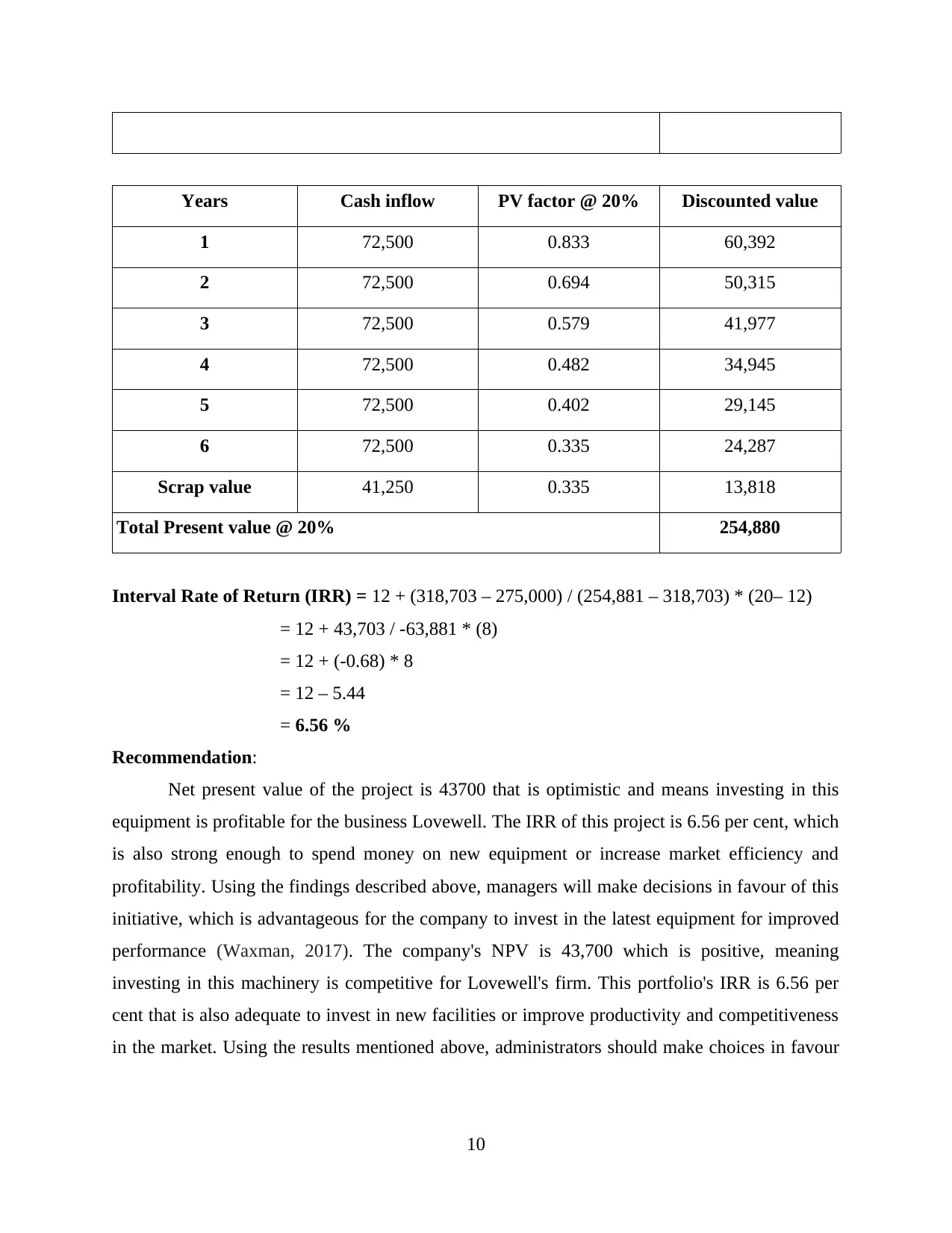
Years Cash inflow PV factor @ 20% Discounted value
1 72,500 0.833 60,392
2 72,500 0.694 50,315
3 72,500 0.579 41,977
4 72,500 0.482 34,945
5 72,500 0.402 29,145
6 72,500 0.335 24,287
Scrap value 41,250 0.335 13,818
Total Present value @ 20% 254,880
Interval Rate of Return (IRR) = 12 + (318,703 – 275,000) / (254,881 – 318,703) * (20– 12)
= 12 + 43,703 / -63,881 * (8)
= 12 + (-0.68) * 8
= 12 – 5.44
= 6.56 %
Recommendation:
Net present value of the project is 43700 that is optimistic and means investing in this
equipment is profitable for the business Lovewell. The IRR of this project is 6.56 per cent, which
is also strong enough to spend money on new equipment or increase market efficiency and
profitability. Using the findings described above, managers will make decisions in favour of this
initiative, which is advantageous for the company to invest in the latest equipment for improved
performance (Waxman, 2017). The company's NPV is 43,700 which is positive, meaning
investing in this machinery is competitive for Lovewell's firm. This portfolio's IRR is 6.56 per
cent that is also adequate to invest in new facilities or improve productivity and competitiveness
in the market. Using the results mentioned above, administrators should make choices in favour
10
1 72,500 0.833 60,392
2 72,500 0.694 50,315
3 72,500 0.579 41,977
4 72,500 0.482 34,945
5 72,500 0.402 29,145
6 72,500 0.335 24,287
Scrap value 41,250 0.335 13,818
Total Present value @ 20% 254,880
Interval Rate of Return (IRR) = 12 + (318,703 – 275,000) / (254,881 – 318,703) * (20– 12)
= 12 + 43,703 / -63,881 * (8)
= 12 + (-0.68) * 8
= 12 – 5.44
= 6.56 %
Recommendation:
Net present value of the project is 43700 that is optimistic and means investing in this
equipment is profitable for the business Lovewell. The IRR of this project is 6.56 per cent, which
is also strong enough to spend money on new equipment or increase market efficiency and
profitability. Using the findings described above, managers will make decisions in favour of this
initiative, which is advantageous for the company to invest in the latest equipment for improved
performance (Waxman, 2017). The company's NPV is 43,700 which is positive, meaning
investing in this machinery is competitive for Lovewell's firm. This portfolio's IRR is 6.56 per
cent that is also adequate to invest in new facilities or improve productivity and competitiveness
in the market. Using the results mentioned above, administrators should make choices in favour
10
Paraphrase This Document
Need a fresh take? Get an instant paraphrase of this document with our AI Paraphraser
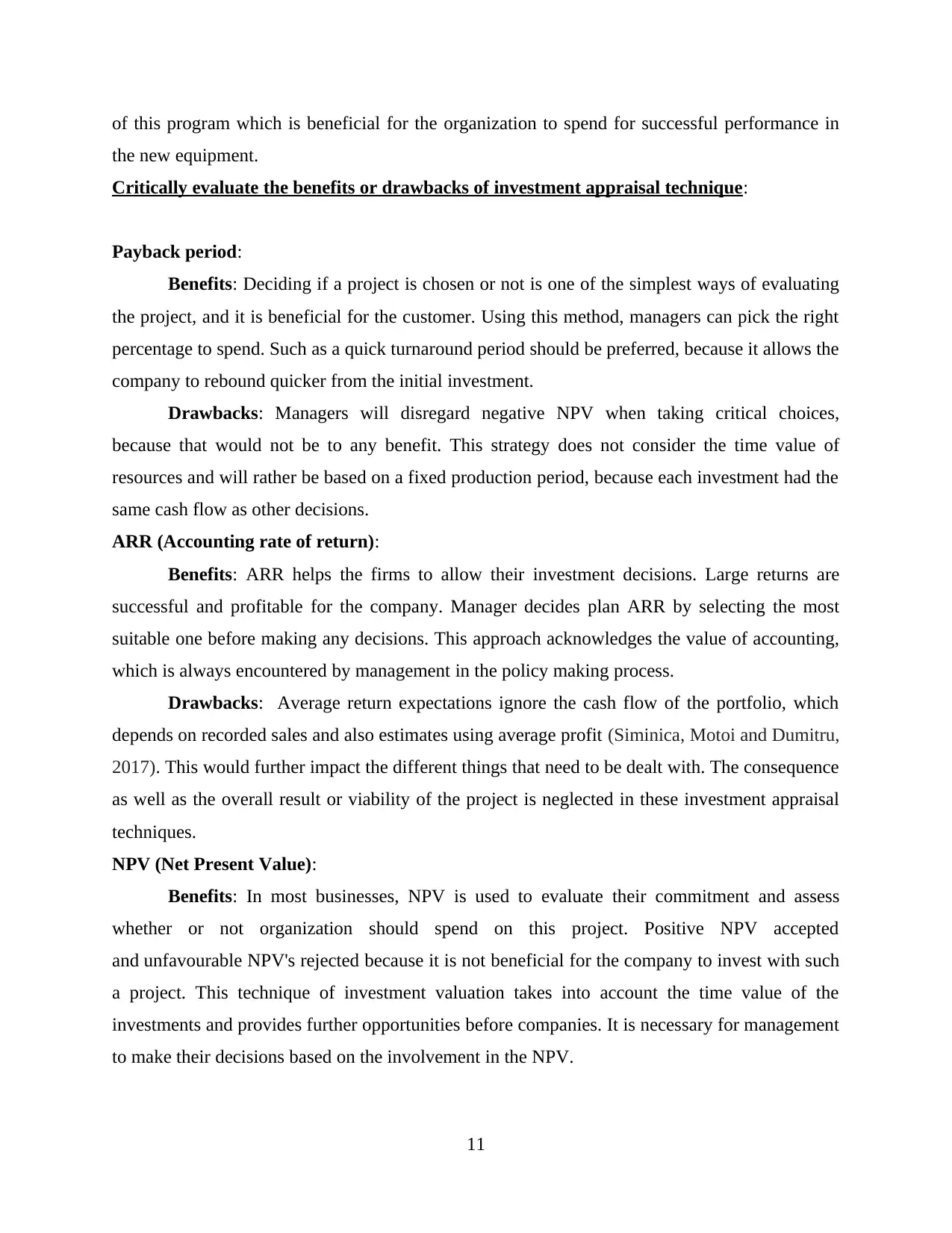
of this program which is beneficial for the organization to spend for successful performance in
the new equipment.
Critically evaluate the benefits or drawbacks of investment appraisal technique:
Payback period:
Benefits: Deciding if a project is chosen or not is one of the simplest ways of evaluating
the project, and it is beneficial for the customer. Using this method, managers can pick the right
percentage to spend. Such as a quick turnaround period should be preferred, because it allows the
company to rebound quicker from the initial investment.
Drawbacks: Managers will disregard negative NPV when taking critical choices,
because that would not be to any benefit. This strategy does not consider the time value of
resources and will rather be based on a fixed production period, because each investment had the
same cash flow as other decisions.
ARR (Accounting rate of return):
Benefits: ARR helps the firms to allow their investment decisions. Large returns are
successful and profitable for the company. Manager decides plan ARR by selecting the most
suitable one before making any decisions. This approach acknowledges the value of accounting,
which is always encountered by management in the policy making process.
Drawbacks: Average return expectations ignore the cash flow of the portfolio, which
depends on recorded sales and also estimates using average profit (Siminica, Motoi and Dumitru,
2017). This would further impact the different things that need to be dealt with. The consequence
as well as the overall result or viability of the project is neglected in these investment appraisal
techniques.
NPV (Net Present Value):
Benefits: In most businesses, NPV is used to evaluate their commitment and assess
whether or not organization should spend on this project. Positive NPV accepted
and unfavourable NPV's rejected because it is not beneficial for the company to invest with such
a project. This technique of investment valuation takes into account the time value of the
investments and provides further opportunities before companies. It is necessary for management
to make their decisions based on the involvement in the NPV.
11
the new equipment.
Critically evaluate the benefits or drawbacks of investment appraisal technique:
Payback period:
Benefits: Deciding if a project is chosen or not is one of the simplest ways of evaluating
the project, and it is beneficial for the customer. Using this method, managers can pick the right
percentage to spend. Such as a quick turnaround period should be preferred, because it allows the
company to rebound quicker from the initial investment.
Drawbacks: Managers will disregard negative NPV when taking critical choices,
because that would not be to any benefit. This strategy does not consider the time value of
resources and will rather be based on a fixed production period, because each investment had the
same cash flow as other decisions.
ARR (Accounting rate of return):
Benefits: ARR helps the firms to allow their investment decisions. Large returns are
successful and profitable for the company. Manager decides plan ARR by selecting the most
suitable one before making any decisions. This approach acknowledges the value of accounting,
which is always encountered by management in the policy making process.
Drawbacks: Average return expectations ignore the cash flow of the portfolio, which
depends on recorded sales and also estimates using average profit (Siminica, Motoi and Dumitru,
2017). This would further impact the different things that need to be dealt with. The consequence
as well as the overall result or viability of the project is neglected in these investment appraisal
techniques.
NPV (Net Present Value):
Benefits: In most businesses, NPV is used to evaluate their commitment and assess
whether or not organization should spend on this project. Positive NPV accepted
and unfavourable NPV's rejected because it is not beneficial for the company to invest with such
a project. This technique of investment valuation takes into account the time value of the
investments and provides further opportunities before companies. It is necessary for management
to make their decisions based on the involvement in the NPV.
11
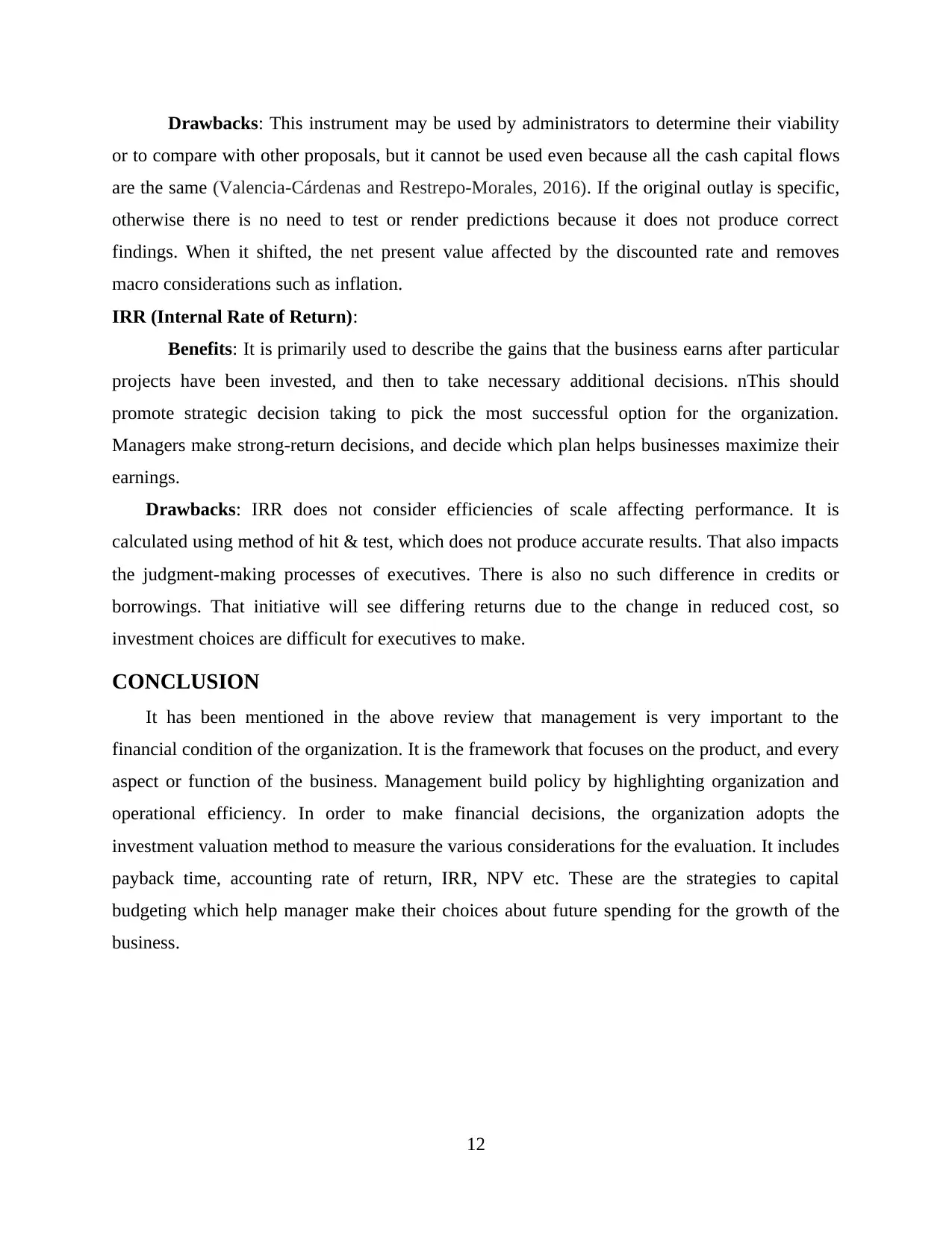
Drawbacks: This instrument may be used by administrators to determine their viability
or to compare with other proposals, but it cannot be used even because all the cash capital flows
are the same (Valencia-Cárdenas and Restrepo-Morales, 2016). If the original outlay is specific,
otherwise there is no need to test or render predictions because it does not produce correct
findings. When it shifted, the net present value affected by the discounted rate and removes
macro considerations such as inflation.
IRR (Internal Rate of Return):
Benefits: It is primarily used to describe the gains that the business earns after particular
projects have been invested, and then to take necessary additional decisions. nThis should
promote strategic decision taking to pick the most successful option for the organization.
Managers make strong-return decisions, and decide which plan helps businesses maximize their
earnings.
Drawbacks: IRR does not consider efficiencies of scale affecting performance. It is
calculated using method of hit & test, which does not produce accurate results. That also impacts
the judgment-making processes of executives. There is also no such difference in credits or
borrowings. That initiative will see differing returns due to the change in reduced cost, so
investment choices are difficult for executives to make.
CONCLUSION
It has been mentioned in the above review that management is very important to the
financial condition of the organization. It is the framework that focuses on the product, and every
aspect or function of the business. Management build policy by highlighting organization and
operational efficiency. In order to make financial decisions, the organization adopts the
investment valuation method to measure the various considerations for the evaluation. It includes
payback time, accounting rate of return, IRR, NPV etc. These are the strategies to capital
budgeting which help manager make their choices about future spending for the growth of the
business.
12
or to compare with other proposals, but it cannot be used even because all the cash capital flows
are the same (Valencia-Cárdenas and Restrepo-Morales, 2016). If the original outlay is specific,
otherwise there is no need to test or render predictions because it does not produce correct
findings. When it shifted, the net present value affected by the discounted rate and removes
macro considerations such as inflation.
IRR (Internal Rate of Return):
Benefits: It is primarily used to describe the gains that the business earns after particular
projects have been invested, and then to take necessary additional decisions. nThis should
promote strategic decision taking to pick the most successful option for the organization.
Managers make strong-return decisions, and decide which plan helps businesses maximize their
earnings.
Drawbacks: IRR does not consider efficiencies of scale affecting performance. It is
calculated using method of hit & test, which does not produce accurate results. That also impacts
the judgment-making processes of executives. There is also no such difference in credits or
borrowings. That initiative will see differing returns due to the change in reduced cost, so
investment choices are difficult for executives to make.
CONCLUSION
It has been mentioned in the above review that management is very important to the
financial condition of the organization. It is the framework that focuses on the product, and every
aspect or function of the business. Management build policy by highlighting organization and
operational efficiency. In order to make financial decisions, the organization adopts the
investment valuation method to measure the various considerations for the evaluation. It includes
payback time, accounting rate of return, IRR, NPV etc. These are the strategies to capital
budgeting which help manager make their choices about future spending for the growth of the
business.
12
⊘ This is a preview!⊘
Do you want full access?
Subscribe today to unlock all pages.

Trusted by 1+ million students worldwide
1 out of 13
Related Documents
Your All-in-One AI-Powered Toolkit for Academic Success.
+13062052269
info@desklib.com
Available 24*7 on WhatsApp / Email
![[object Object]](/_next/static/media/star-bottom.7253800d.svg)
Unlock your academic potential
Copyright © 2020–2025 A2Z Services. All Rights Reserved. Developed and managed by ZUCOL.





